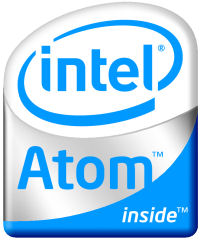Intel unveils Atom: new microarchitecture for UMPCs, MIDs
 When you make smaller transistors, you can make much smaller processors, and the immediate payoff is that you use less power. The trick is to make the consumer want the smaller processor, and that may not be as easy as having invented the thing.
When you make smaller transistors, you can make much smaller processors, and the immediate payoff is that you use less power. The trick is to make the consumer want the smaller processor, and that may not be as easy as having invented the thing.
You know Intel's coming into this year's CeBIT conference in Hannover with a full arsenal of innovations when it makes its first announcements on Sunday just to be able to fit everything in. This morning, the latest upshot of its discovery of the high-k-plus-metal-gate (HK+MG) process takes center stage, with an entirely new 25 square-micrometer processor called Atom whose thermal design point plunges as low as 0.6 watts.
TDP is the measurement of how much cooling power is required to bring a chip down to a nominal temperature level. Although the metric continues to be called into question, especially by Intel's sole CPU rival AMD, the relative comparisons remain striking: Current Core 2 Mobile processors plunge to about 31 W TDP; whereas on the opposite end of the scale, Intel's enthusiast-class quad-core QX9770 tops out at 136 W TDP.
The real comparison will take place, however, between Intel's Atom series and AMD's Geode embedded processors. Available since 2005, the standard-power Geode taps a TDP of 5.1 W, while its low-power LX 700 dials it down to 3.1 W. If Atom stays within the range 0.6 - 2.5 W while being clocked at 1.8 GHz -- a full 300% higher frequency than the Geode LX 900 and 415% faster than the LX 700 -- then AMD will need a counter-punch very, very quickly.
Atom is intended for that category that Intel is now called "mobile Internet devices" (MIDs), created last April when the company made a clean break from the UMPC "Origami" project spearheaded by Microsoft. Still, Atom may be the power plant behind a number of UMPC devices slated to be launched at CeBIT this week, including perhaps the latest from Asus.
The HK+MG lithography process enables Intel to miniaturize its transistors by at least 40%, and thus pack them closer together without fear of power leaks. It's actually a fact of physics that such smaller devices must consume lower power in order to be functional.
While the manufacturing process will almost certainly take off, with AMD and IBM partnering on a similar process, the small, networkable device market has yet to find its niche among consumers. Powerful handhelds like Windows Mobile 6 and BlackBerry have already made inroads, and with handheld users also typically owners of notebook PCs, there remains very little room to stage a new market in "ultra-mobiles."
Still, that doesn't leave Atom without a chance. Theoretically, a MID device may only require architectural success, if not an established market presence, in order to make a value proposition for Atom in the market where it could truly take off: small embedded systems that require the programmability and manageability of a desktop computer, such as security checkpoints, contactless payment stations, and the market where Microsoft actually is making inroads: automotive computing. Imagine a voice-capable version of Outlook where your car stereo rests now.